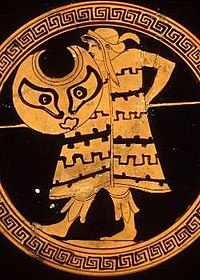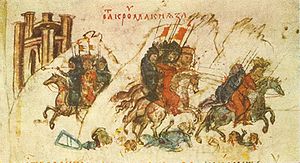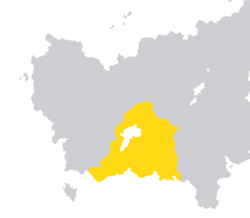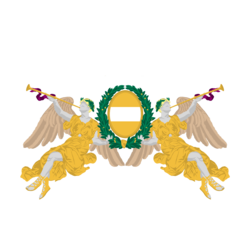History of Tengaria
The following article details the History of Tengaria.
Early History (before 495)
Main article: Kaloí Civilization, Armonic Civilization, Marolevic Migrations

Archeological records of settlement around the Len River Valley date back thousands of years. The earliest known records for the region was originally inhabited by a group of tribes known as the Kaloí, who were related to other tribes of Dytikoí and Satrio-Euclean origin, a name first recorded by the Piraean settlers. Little is known about the Kaloí outside of the artifacts they had left behind and accounts given by the Piraeans and later the Solarians. They were described by such as a mostly peaceful people, and were well known for their music and their fair features. They kept mostly to rural farming communities, however, the tribes were known to still wage war against one another or against migratory groups. Although they left no written records, they did have their own language, worship their own gods, and had a common culture, leaving behind burial chambers, settlements, and religious artifacts. They are also credited with developing the fighting style of the Peltast, which spread through Istros to the rest of the Piraean world.
Piraean settlers settled in the southwest region, and also the city of independent city state of Istros along the central Southern Coast in the seventh century BCE. This first coastal city first exposed the Kaloí to the civilization of the Piraeans, and was the largest city in the region for many years. The Piraean language and system of writing did spread to some of the southern tribes, but did not reach most of the tribes. Around 450 BC, many various tribes of the Kaloí were united under one King, Peirous, who formed the Kingdom of Kaloia. This Kingdom only encompassed the southern and central region of modern Tengaria, focused around the Len River Valley and the Coastal Plains. Although there were kings who had knowledge of Piraean civilization, very few cities were built, save for a city on the banks of the Len which eventually came to be Lenovo. Other distinct Kaloí tribes remained outside of the Kingdom as well, especially upon the northern hills.
In addition to the Kaloí, Tengaria was also home to another civilization, that of the Armonic peoples, who lived in the northwestern and western portions of the country. Eventually this civilization would began to expand and to found city states, eventually forming the Armonic League in the region of Visoclesia along the coast of Lake Min. However, Armonic civilization existed well beyond the League in various tribes and petty kingdoms, which occasionally made war with the Kaloí. The word Armonic comes from the corruption of the Solarian name for the region, Harmonica, named in part of the music of said civilization, and because they were reportedly held to be kinsmen to the Kaloí and as such bore much of their character.

When the Solarians first conquered Amathia, some of the Priedan tribes fled to Kaloia as a means of escape. Now the realms of the Kaloí were located at the far borders of the Solarian Empire, and occasionally engaged in warfare with the Empire. The Empire did make several incursions into the Kaloí lands and even for a time controlled a slight portion of eastern marches of Tengaria. For the most part however, this border territory was often the center of many conflicts between the Solarians and the Kaloí, as disputed territory saw warfare between the two. Several settlements and border forts in the East of Solarian origin have been discovered, but they are sparse. While the Kaloí were exposed to Solarian culture, it did not become widespread as of that time. However, Sotrianity is regarded as spreading to Istros in the region in the first few centuries, and John the Apostle was said to be exiled there during his final days. Despite being in conflict with the Solarian Empire in the initial centuries, the Kaloí eventually began to make alliances with the Solarians, hiring themselves as mercenaries.
When Marolevs eventually invaded the land from the North, the Kaloí were driven either towards the Sea, into the hilly parts of the country, or into Solaria itself. Most of the Kaloí fled to their kinsmen in modern Amathia and became foederati of the Amathians. The Armonic peoples were crushed and scattered, and the city states greatly reduced; many fled northwards, and are speculated to have later became the Kireno-Kantemoshan peoples, while still others adopted a migratory lifestyle, and became the Savaders. A pocket of Armonic civilisation survived, which would become Armonia. Many Marolevs passed through the land on their way to Solaria. The ones which stayed in the region were known as the Tengars. Once they had come dominate the region during the waning days of the Empire, the Solarians first called the region "Tengaria", which the region was referred to as henceforth. Eventually the Western Empire collapsed in 426, but the Empire of Arciluco continued to hold on in the East. The Tengars assimilated much of the remaining Kaloí and Armonic peoples, and came to dominate certain parts of the region.
Imperial Tengaria (495-1935)
Rule by the Empire of Arciluco and Vicariate (495-1385)
Main Article: Empire of Arciluco, Vicariate of Tengaria
By the time the Marolevic invasions of Solaria had begun to cease, the Tengars had already largely established themselves in the lands roughly corresponding to the border of Tengaria. However, the power to the East, the Empire of Arciluco, looked to expand its borders westward. With the help of the Preidans and the Kaloí foederati, Arciluco conquered most of current day Tengaria into the Empire following a successful series of campaigns lasting from 480 to 495. The Tengar tribes were incorporated into the Empire first as foederati, and most of modern Tengaria was divided into three administrative divisions, known as dioceses. The eastern one, closest to Amathia, was populated with Kaloí, and became known as the Diocese of Calia. The southern coast, which was largely taken over by Tengars but had a Piraean minority, was formed as the Diocese of Istros. The final one, the largest and westernmost one, was called the Diocese of Tengaria, but also included the region of Armonia, where the Savaders who remained were also made foederati of the Empire. A colony was founded on the remnants of an old Kaloí settlement, which was called Urbs Lenis, as the administrative centre. This city would come to be known as the city of Lenovo.
The Empire of Arciluco began a process of integrating the foederati into the structure and culture of the Empire. At the beginning of the sixth century, Saint Mihail of Tengaria, a missionary from Arciluco, brought Sotrianity to the Tengar tribes. Due to Mihail's position in the historic see of Istros, the Bishop of Istros would become the spiritual centre of the rising Tengarian Church. Through the efforts of Amathian missionaries, the language Tengarians spoke was used to develop the first Marolevic literary language, known as Old Church Marolevic, although it was never used for the Tengars. This langauge would come to be the standard liturgical langauge for almost all Marolevic peoples, although it would later be reformed. As Arcilucan culture began to spread, Vulgar Solarian accompanied it and became dominant throughout most of the provinces, but many Tengars in rural areas continued to speak their own toungue, although it began to substantially change under Solarian influence. It was during this time that the populace shifted towards identifing as Solarians, despite linguistic differences, and linguistic and ethnic identies became more regional.
The Diocese of Tengaria, as a border province of the Empire and major stategic point against the Marolevic tribes, developed quickly, with the city of Lenovo becoming the second most important city in the Empire following Arciluco. Following centuries of gradual weakening of Amathian rule and a failed uprising by a general named Geto, in 1121 the Western regions of the Empire were consolidated under the more autonomous Vicariate of Tengaria in an attempt to better provide protection against increasing threats outside of the Empire's borders. The leaders, known as Vicarius et Comes, was hereditary under the rule of the a cadet branch of the Cyriacan Dynasty. They became one of the most important military and political positions within the Empire of Arciluco, competing with the Magister Utriusque Militiae and the Eastern Vicarius et Comes, and were major players in Imperial politics.
Eventually, the Empire would face its greatest internal crisis in centuries- the Iconoclast Crisis. The political and religious figures in the region of Tengaria consistently supported the iconodule side of the debate, arguing for the use of icons in the worship. Eventually, however, the Iconoclastic Order of Thorns revolted against the iconodule Emperor, with the Vicariate under Vicar et Comes Vasil firmly supporting the Emperor's side. The Order of Thorns' capture of the city of Arciluco in 1385 and the subsequent impaling the Emperor sparked the collapse of Imperial institutions in the capital, and leaving a power vaccum throughout most of the Empire. In the wake of the collapse, this void was filled by the Vicariate and the newly declared Realm of Thorns. The exiled iconodule Ecumenical Patriarch, iconodule Amathian Bishops, and the royal family fled to Tengaria, and Vasil was able to consolidate control of the vast majority of Imperial territory. Upon the confirmation of a synod of Bishops and under the authority of the Ecumenical Patriarch, was elected and crowned the next Emperor, thus translating the Empire from Amathia to Tengaria and resulting in the creation of the Empire of Tengaria.
Imperial Era (1385-1927)
Main Article: Empire of Tengaria
Upon Vasil's proclamation as Emperor, it was expected that he would recapture Arciluco and purge the Iconoclasts from the city. However, despite taking control of the majority of old Imperial territory, he was never able to seize the city of Arciluco itself from the Iconoclasts, and was eventually forced to settle for a truce with the Realm of Thorns which would last the rest of his lifetime. Because of this change of focus, Vasil instead rebuilt or reformed the Imperial institutions to the city of Lenovo, which became the new Imperial Capital and the seat of power. In order to increase this legitimacy, the daughter of the last impaled Emperor was married to Vasil's son and heir, and he himself was confirmed in his Imperial authority by a full council of the Church at the Council of Lenovo. His reign marked the beginning of the Tengarian Golden Age, a period of intellectual and philosophic flourishing and cultural renewal. Tengaria became the major intellectual and spiritual centre of Western Euclea, with the establishment the University of Lenovo as the first University in Western Euclea in 1392. His reign also saw a rapid expansion of territory to the west and north, firmly placing the Empire as the dominant political state of Western Euclea.
Once Vasil I had died and was succeeded by his grandson, Vasil II, the Empire was ready to engage the Iconoclasts on the field of battle. As its position as leader of the Episemialist world, Tengaria became involved in the Iconoclast Wars in 1408 supporting the Duchy of Pavatria against the Kingdom of Ravnia, the Realm of Thorns, and rebellious iconoclastic Bistravians. During the war, Vasil invaded Amathia and was able to defeat the forces of the Realm of Thorns in battle, hold the western marches, and even was able to capture more territory from the iconoclasts. However, he was never able to capture his goal of Arciluco, despite several failed sieges of the city, and he lost most of the lands he did manage to gain when the iconodule Unio Trium Nationum came into power. Vasil II was able to decisively crush the Bistravian revolt and restored control over the region. After decades of fighting, however, and although no territory was ultimately lost, the iconclasts had scored a de jure victory. Tengaria's final failure to capture the old Imperial capital of Aciluco caused a rift with the Amathian territories, who did not view Tengaria's title as legitimate.
Despite of Tengaria's failure to consolidate firm victory, Tengaria's political, cultural and intellectual power in Western Euclea continued. The city of Lenovo functioned largely as the culutral capital for Western Euclea, and was a source of great learning, literary and philosophical development, and eventually what ended up causing the creation of the University over the lands of Western Euclea. Tengaria reached its greatest territorial extent by the middle of the 16th century. However, the power was not to last indefinitely. The rising power of the Soravian Empire saw much of the prominence turn from Lenovo to Samistopol, and as Soravia's political power began to grow, Tengaria was displaced as a hegemeon. Gradually Tengaria lost territory during the seventeenth and eighteenth centuries to Ravnia, Soravia and the Kingdom of Amathia. Despite facing major territorial losses, Tengaria was strong enough to keep from being conquered but not enough to make itself a preminent power like it had been before.
In the beginning of the nineteenth century, the Empire began to fall into the sphere of Soravia, becoming an ally and influenced by it. In 1868, in the wake of the failed Republican Green Revolution, the historic Senate was reformed into into a permanent body. Over the next few decades, gradual modernisation and industrialisation would take be brought to Tengaria, although it lagged behind Eastern Euclea in terms of economic development. He worked to bring in modern infrastructure and industrialization from Eastern Euclea, and laid the groundwork for much of Tengaria's later development. The very end of the nineteenth and early twentieth centuries saw a time of economic prosperity and cultural rebirth in architecture and intellectual thought. Tengaria was not hit quite as hard by the Great Collapse, but the rapid development stagnated, only picking up briefly before the world was plunged into the fires of War in 1927.
The Great War (1927-1935)

At the outbreak of the Great War, Tengaria's ally Soravia entered the Grand Alliance. Although supportive of the Alliance due to concerns over Amathian irredentism, Tengaria was hesitant to enter the war out of concerns that it would be overwhelmed, and so remained neutral through the opening two years of the war. However, as the Entente front in Western Euclea failed, Tengaria's neutrality was violated in 1929 order to open a new front and provide reinforcements from Eastern Euclea. After a few months of fighting, Amathian forces broke through and swept over most of Tengaria, capturing the city of Lenovo and forcing the government to go into exile in Soravia, although the Emperor chose to stay behind and was captured by Amathian forces. Simeon Kovachev, a young general who had distinguished himself, gathered what remnants of the army that he could into the Visoclesian hills to wage guerrilla war against the Amathians with a resistance force known as the Free Solarian Army.
With the government having fled, the Amathians annexed much of Tengaria and formed the puppet collaborationist rump state called the Tengarian State, mostly from republican or nationalist figures who had been kept out of power during the Empire, forming Tengaria's first republican government. The regime was opposed by both by many on the right, who backed Kovachev, as well as left-wing groups, who formed other resistance cells and miltias. Eventually, as the Entente began to collapse, famine broke out across the country and after several massacres including the assassination of the Emperor in prison, popular support against the Amathians and the regime plumeted. Now with significant Soravian support and a faltering Entente war effort, the Free Solarian Army was able to push back and drive back the Amathian forces.
In the immediate aftermath of the war and with the Emperor having been killed, Kovachev accepted the title of regent until the Emperor's successor could take his place. Kovachev took actions to rebuild the country, punish the collaborators, and put down the left-wing militias in the country, and initially had the support of the Soravians in the following period. As the situation was finally stablized in Tengaria by 1935, Kovachev began preparations to step down with the resumption of power in the monarchy. Soravia, not wanting the country to return to the system and with significant influence in Tengaria for having helped to liberate it, worked with the moderate Constitutionalist Party to impose a new pro-Soravian republic on the country instead, preventing a full restoration from taking place. Simeon, as a known anti-councilist, was allowed to retain command of the armed forces.
Modern Era (1935-present)
First Republic (1935-1948)
Main Article: Tengarian Republic
The new republic, imposed by Soravia, was founded as a semi-presidential republic, and held its first elections of the new Republic were held in August of 1935, with Ioan Acirili becoming Tengaria's first President entering office in November of the same year. Political interest in the new republic was very low, and a plurality of parties in the legislature meant that goverments proved extremely difficult to form and to keep running. Lingering economic issues from the war quickly plagued the early republic, with no formed government from the legislature being adequitely able to deal with the issue. Soon, the Republic became known for extreme political instability- in its 12 years of existence, the Republic had 17 governments, only one of which lasted longer than a year. The legislature was bogged down by constant infighting and disputes, and accomplished very little.
In 1940, the former collaborator and nationalist Vasil Stoychev took the Presidency, although under his administration the political problems grew worse. As the parties continued to be unable to solve the issues the country was facing, popular support for the government dwindled. Despite winning a second term in 1945, Stochev was unable to keep hold of a government, leading to people blaming the partisan infighting and lack of stability on the system. Protests against the government grew in number and intensity, and support the right-wing All-Solarian Union increased, much to the dismay of Stoychev and his supporters. During this time, Tengaria also participated in the Solarian War against Etruria, helping Soravia on the Western front of the war.
As the economic situation had worsened significantly by 1947, Stoychev's led the left-wing parties to consolidate into a group known as the Republicans in an attempt to finally break through the gridlock. However, this attempt still failed to get a majority in the Senate in the subsequent snap elections. With this move having failed and popular support dwindling Stoychev labled the economic crisis a "national emergency" and used it as an excuse to adopt emergency powers before the newly-elected Senate had a chance to convene. Stoychev began using these powers to silence and arrest political dissidents. This move was seen by many as a self-coup. As a response, Simeon Kovachev, with the support of the military, launched a counter-coup against Stoychev, successfully arresting him and taking power as provisional head of government. As Kovachev was a trusted figure due to his status as a war hero, the counter-coup was celebrated and widely accepted across the country and he and his supporters regarded themselves as "patriots".
In the aftermath of the counter-coup, Kovachev founded the Patriotic Union with the goals of establishing political stability and order while ending partisanship and political conflict. After 12 years of dysfunctional government, the idea was massively popular and generally well-recieved by the populace. Kovachev allowed the elected Senate to take their seats, and acquired their approval to hold a referendum on adopting a new constitution, which passed with an overwhelming majority. The new constitution, in which the Presidency was stronger and had more ability to prevent the issues which had happened in the first republic, was written to minimize the effects of civil strife and factionalism. The constitution was approved by referendum in 1948, and soon after Kovachev was elected as the new President of Tengaria and the Patriotic Union took power.
Second-Constitution Tengaria (1948-present)
Under Kovachev's economic policies, Tengaria saw an economic boom over the next two decades, overcoming much of the debt the republic had wracked up. He revitalized Tengarian education, making it one of his chief priorities to do so. His efforts saw government influence extend over many fields of culture, such as the type of arts it promoted and sponsored. In addition to education and culture, Kovachev also expanded Tengaria's infrastructure, such expanding Tengaria's rail and energy system, such as subsidizing the first thorium-based nuclear power project on a country-wide scale. Many of these would be finished by his son Dimitri. Kovachev finally died of natural causes on January 2, 1983, when he was 81 years old.
Following Simeon's death, a series of Presidents of the Patriotic Union took power. These tended to be less philosophical and pragmatic, but continued the solid domination of the Patriotic Union as the main political body. The country was beset with a financial crisis soon after Simeon's death the 1980s, the succeeding Presidents were not quite as popular as Kovachev had been. Tengaria remained geopolitically close to Soravia in the wake of the Dissolution of the UPSR and brought Tengaria into the diplomatic bloc of Samorspi in 1984. In 2012, Simeon's grandaughter Teodora Kovacheva was elected the Presidency. At the time, she was thirty years old, making her one of the youngest heads of state in the world at the. Teodora has claimed that it is her priority to reembrace the Patriotic Union and its principles, and to cut back on corruption from the intervening period.






